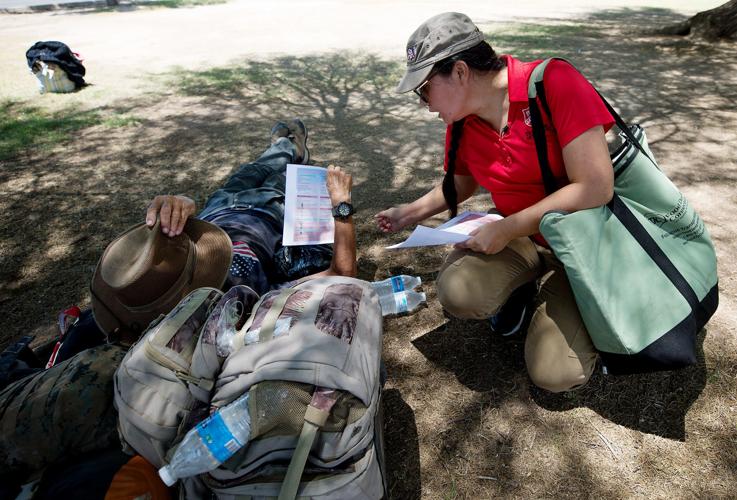Glenda Avalos, with the Salvation Army, hands an ice-cold bottle of water to a man sitting in a patch of shade in Santa Rita Park. Scott Miller is one of a couple dozen people experiencing homelessness who spend a chunk of their day avoiding the heat under trees in the park on Tucson’s south side.
Tuesday was the first day of the Salvation Army’s Operation Chill Out, with the temperature exceeding 100 degrees. Avalos, Salvation Army Tucson public relations director, will be passing out water, sun hats, sunblock and other heat-relief supplies at Santa Rita and De Anza parks every day the heat reaches 102 through Aug. 31.
“What we’re doing is raising awareness,” she says. “These waters seem very simple, but they’re lifesaving.”
Along with the cold water, pulled from a cooler bag slung over her shoulder, Avalos hands Miller a flyer with a list of summer respite places, coordinated by the Tucson Pima Coalition to End Homelessness. The flyer has 11 summer sites that offer extra homeless services during the summer, like indoor facilities where people can hang out, sack lunches and, of course, lots of water.
Miller, 59, has been homeless for just over a year. He says staying hydrated during the summer is one of the hardest parts of dealing with the extreme heat while being outdoors most of the day. He tries to take advantage of the local summer respite efforts.
The Pima County Health Department partners with the coalition in these efforts to reduce heat-related illness and death. Aaron Pacheco, spokesman for the health department, says a person’s housing status can directly affect their health for a number of reasons, one of which is dealing with the summer heat.
“For folks that are experiencing homelessness, there’s definitely an increased risk when it starts to warm up,” he says.
Statistics on how many people experiencing homelessness have heat-related emergency-room visits are hard to come by. But overall heat-related illness emergency room visits were at 332 in Pima County in 2017, according to the Arizona Department of Health Services. Statewide, those 2017 numbers were the highest, by far, in June. There were also 26 heat-related deaths in Pima County in 2017.
Making her way around the park, Avalos gives Earl Hedges a couple of water bottles and some sunblock. Hedges has been homeless on and off since 2013. He says the water helps stave off the effects of the heat, but he sees a need for more day shelters.
Most places on the summer respite list that have a daytime place to get indoors also have a capacity, ranging from 10 to 75. Tucson and Pima County’s joint 2018 point-in-time count, which is an estimate of one day’s homeless population, counted 229 people experiencing homelessness.
Hedges had heatstroke a few summers ago. The 48-year-old says someone saw he was unresponsive and called 911. Besides heat-related illness, he says hygiene is another big concern during the summer, with sweating more and having nowhere to cool off.
One place a number of people experiencing homelessness go to cool off is the public library. People wait outside the Joel D. Valdez Main Library downtown most mornings for the doors to open at 9 a.m. and let them into the air-conditioned haven.
The main library and other library branches are on the summer respite list. The main library offers a place to cool off, use computers, read, get help with a job search and even to see a nurse for consultations, referrals and hepatitis A vaccines. The library also accepts and distributes donations for people experiencing homelessness.
Kate DeMeester, the main library branch manager, says the library is an important cooling center for many people in the community, including those experiencing homelessness.
“We’re free, and we’re open to everyone,” she said. “We welcome everyone, and that’s pretty rare. The library is happy to be in that role for people.”
Another place on the summer respite list where people can hang out indoors is La Frontera-RAPP, a resource center on Tucson’s south side, all of June and July Monday through Friday, from 8 a.m. to 4 p.m.
Operating on a federal grant and with food from the Community Food Bank, the center has computers, a phone, water and sack lunches. The center is accepting donations of water, hats, sunscreen, sunglasses and flip-flops.
“Every year when it starts getting hot, we definitely see more people coming in,” says recovery coach Valerie Grothe.
She says the center’s staff will call 911 if someone exhibits signs of heatstroke or heat exhaustion, which usually happens a few times a summer.
Many of the places on the summer respite list accept and rely on donations from the community. People can drop off donations at La Frontera’s RAPP center at 1082 E. Ajo, Suite 100.
Avalos expects to pass out between 130 and 200 water bottles a day, and as many as 640 on some of the hottest days. People can donate to Operation Chill Out by paying for water bottles and heat relief materials at the register of any Albertsons or Safeway store throughout June.
Besides water bottles, the effort needs donations of sunscreen, lip balm, hats, umbrellas, sunglasses and light-colored clothing. Donations can also be dropped off at any Naughton’s Plumbing or brought to the Salvation Army Hospitality House, 1002 N. Main Ave.
Online donations are accepted at SalvationArmyTucson.org/operation-chill-out or by calling the Hospitality House at 622-5411.
Avalos says she not only offers people water but conversation and compassion. She says summer homeless efforts take teamwork of the whole community.
“There is a need that’s never-ending,” she said. “It doesn’t matter at what point you’re at, you’re a human being.”





